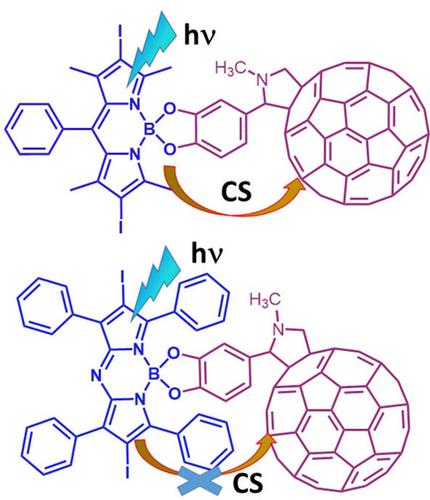当前位置:
X-MOL 学术
›
ChemPhotoChem
›
论文详情
Our official English website, www.x-mol.net, welcomes your
feedback! (Note: you will need to create a separate account there.)
Triplet BODIPY and AzaBODIPY Derived Donor‐acceptor Dyads: Competitive Electron Transfer versus Intersystem Crossing upon Photoexcitation
ChemPhotoChem ( IF 3.0 ) Pub Date : 2019-09-10 , DOI: 10.1002/cptc.201900189 Shuai Shao 1 , Habtom B. Gobeze 1 , Venugopal Bandi 2 , Christiane Funk 1 , Brian Heine 1 , Maddie J. Duffy 3 , Vladimir Nesterov 1 , Paul A. Karr 3 , Francis D'Souza 1
ChemPhotoChem ( IF 3.0 ) Pub Date : 2019-09-10 , DOI: 10.1002/cptc.201900189 Shuai Shao 1 , Habtom B. Gobeze 1 , Venugopal Bandi 2 , Christiane Funk 1 , Brian Heine 1 , Maddie J. Duffy 3 , Vladimir Nesterov 1 , Paul A. Karr 3 , Francis D'Souza 1
Affiliation

|
The bis‐iodo β‐pyrrole‐substituted BF2‐chelated dipyrromethene, I2BODIPY, and its structural analogue BF2‐chelated aza dipyrromethene, I2azaBODIPY, carrying a nitrogen at the meso‐position instead of carbon, were synthesized and characterized as new set of triplet sensitizers using different techniques. These sensitizers were further functionalized with fullerene, C60, at the central boron atom to build donor‐acceptor conjugates. Using spectral, electrochemical, and computational methods, these conjugates were characterized, and the energy levels were established. Intersystem crossing to populate the triplet state was observed upon excitation of I2BODIPY and I2azaBODIPY, however, the measured rates of kISC were found to be nearly two orders of magnitude higher for I2azaBODIPY (kISC∼1011 s−1) compared to I2BODIPY (kISC∼109 s−1). The energetics, kISC, and position of HOMO and LUMO levels was found to control the ability of the dyad to undergo electron transfer, although the donor‐acceptor distances were virtually the same in both I2BODIPY‐C60 and I2azaBODIPY‐C60 conjugates. Free‐energy calculations revealed that the photoinduced electron transfer process was thermodynamically feasible from only the singlet excited states in both conjugates. Consequently, electron transfer from the 1I2BODIPY* in competition with intersystem crossing was witnessed in the case of I2BODIPY‐C60 dyad while in the case of I2azaBODIPY‐C60 dyad, excitation of azaBODIPY led to a short‐lived charge transfer state involving the catechol bridge followed by populating the low‐lying 3I2azaBODIPY* state without promoting the process of charge separation involving C60. The lifetime of the charge‐separated states was in the ns range in the I2BODIPY‐C60 conjugate both in polar and nonpolar solvents.
中文翻译:

三重态BODIPY和AzaBODIPY衍生的供体-受体染料:光激发下的竞争性电子转移与系统间交叉
双碘β吡咯取代的BF 2 -chelated二吡咯亚甲基,我2 BODIPY,其结构类似物BF 2 -chelated氮杂二吡咯甲川,我2 azaBODIPY,在携带氮内消旋-位,而不是碳,被合成和表征作为使用不同技术的一组新的三重态敏化剂。这些敏化剂在中心硼原子上被富勒烯C 60进一步官能化,以建立供体-受体结合物。使用光谱,电化学和计算方法,对这些共轭物进行了表征,并确定了能级。激发I 2时观察到系统间交叉以填充三重态BODIPY和我2 azaBODIPY,然而,所测得率ķ ISC被发现是近两个数量级的更高的I 2 azaBODIPY(ķ ISC〜10个11 小号-1相比I)2 BODIPY(ķ ISC〜10个9 小号-1)。尽管I 2 BODIPY-C 60和I 2 azaBODIPY-的供体-受体距离实际上相同,但是高能,k ISC以及HOMO和LUMO的水平位置可以控制二元体进行电子转移的能力。C60个结合物。自由能计算表明,光诱导的电子转移过程仅从两个共轭物中的单重激发态在热力学上都是可行的。因此,在I 2 BODIPY-C 60 dyad的情况下,观察到了与系统间交叉竞争时从1 I 2 BODIPY *进行的电子转移,而在I 2 azaBODIPY-C 60 dyad的情况下,azaBODIPY的激发导致了短路-涉及邻苯二酚桥的活性电荷转移状态,然后填充低位的3 I 2 azaBODIPY *状态,而没有促进涉及C 60的电荷分离过程。在极性和非极性溶剂中,I 2 BODIPY-C 60共轭物中电荷分离态的寿命都在ns范围内。
更新日期:2019-09-10
中文翻译:

三重态BODIPY和AzaBODIPY衍生的供体-受体染料:光激发下的竞争性电子转移与系统间交叉
双碘β吡咯取代的BF 2 -chelated二吡咯亚甲基,我2 BODIPY,其结构类似物BF 2 -chelated氮杂二吡咯甲川,我2 azaBODIPY,在携带氮内消旋-位,而不是碳,被合成和表征作为使用不同技术的一组新的三重态敏化剂。这些敏化剂在中心硼原子上被富勒烯C 60进一步官能化,以建立供体-受体结合物。使用光谱,电化学和计算方法,对这些共轭物进行了表征,并确定了能级。激发I 2时观察到系统间交叉以填充三重态BODIPY和我2 azaBODIPY,然而,所测得率ķ ISC被发现是近两个数量级的更高的I 2 azaBODIPY(ķ ISC〜10个11 小号-1相比I)2 BODIPY(ķ ISC〜10个9 小号-1)。尽管I 2 BODIPY-C 60和I 2 azaBODIPY-的供体-受体距离实际上相同,但是高能,k ISC以及HOMO和LUMO的水平位置可以控制二元体进行电子转移的能力。C60个结合物。自由能计算表明,光诱导的电子转移过程仅从两个共轭物中的单重激发态在热力学上都是可行的。因此,在I 2 BODIPY-C 60 dyad的情况下,观察到了与系统间交叉竞争时从1 I 2 BODIPY *进行的电子转移,而在I 2 azaBODIPY-C 60 dyad的情况下,azaBODIPY的激发导致了短路-涉及邻苯二酚桥的活性电荷转移状态,然后填充低位的3 I 2 azaBODIPY *状态,而没有促进涉及C 60的电荷分离过程。在极性和非极性溶剂中,I 2 BODIPY-C 60共轭物中电荷分离态的寿命都在ns范围内。











































 京公网安备 11010802027423号
京公网安备 11010802027423号